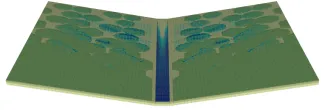Coupling Surface and Subsurface Hydrology in Complex Terrain
Watershed function, including a watershed’s ability to provide clean, available water, is often significantly altered by the local complexity of the land surface and underlying soils. Understanding that complexity requires models that can first represent the complexity and next solve for real-world scenarios of water conditions accurately and efficiently. The new mathematical formulation, implemented in DOE’s Advanced Terrestrial Simulator (ATS), allows scientists to accurately predict how water flows both below and on the surface of these complex landscapes, including how it partitions between groundwater and surface runoff to streams. In this work, the method was derived, tested against a series of benchmark problems, and shown to be more accurate than previously used methods on complex landscapes.
This and other advances in ATS allow scientists to accurately simulate the water cycle in complex landscapes, including cases of post-fire storms on patchy burn scars and variable depth-to-bedrock. This capability takes a major step toward better predictions of water availability and quality in realistic watersheds.
Understanding how the water cycle is responding to drought, fire, warming, and increased human demand requires computer models that can represent complex environments. In a recent paper, DOE scientists and mathematicians derived a new mathematical formulation that greatly improves the ability of models to predict runoff, even in cases where the soil structure is complicated. In particular, cases like patterned land cover, variable soil layers, and other complex soil conditions make accurate predictions hard; this method is robust to even the most complex landscapes.
Most natural landscapes are complex, and that complexity is both hard to measure and hard to simulate. A method that is robust to that complexity greatly improves scientists’ ability to predict how the water cycle will change in actual watersheds. These predictions can then in turn inform local stakeholders in these watersheds when making decisions around water use.
An example simulation showing a patterned ground with variable land cover (in greens) and surface water (in blues) during a rainstorm. The green, organic-rich soil, thanks to a higher porosity, is able to store more water. This changes the hydrologic response of the entire catchment: accurate representation of the land cover is required to accurately predict runoff.
Image courtesy E. Coon (ORNL)
Coon, Ethan T., et al. (ATS development team) "Coupling surface flow and subsurface flow in complex soil structures using mimetic finite differences." Advances in Water Resources 144: 103701 (2020). [DOI: 10.1016/j.advwatres.2020.103701]
This work and its large team of investigators was continuously supported over a long period by several DOE Office of Science, Biological and Environmental Research projects, including the Next Generation Ecosystem Experiment – Arctic project, the Interoperable Design of Extreme-scale Application Software (IDEAS) project, and Laboratory Directed Research and Development funds from both Oak Ridge and Los Alamos National Laboratories.
For more information, please contact:
Ethan Coon
coonet@ornl.gov

